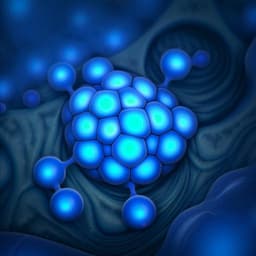
Engineering and Technology
Fast hydrogen purification through graphitic carbon nitride nanosheet membranes
Y. Zhou, Y. Wu, et al.
Explore the remarkable advancements in gas separation technology with lamellar g-C3N4 nanosheets, developed by Yisa Zhou and colleagues. These innovative membranes not only offer unprecedented H2 permeance but also showcase exceptional stability, making them a game-changer in harsh environments. Dive into the future of efficient gas separation!
~3 min • Beginner • English
Introduction
The study addresses the need for efficient hydrogen purification to support carbon neutrality goals, as most produced hydrogen is mixed with larger molecules such as CO2, N2, and CH4. Conventional separation methods like distillation and pressure swing adsorption are energy intensive, and polymer membranes face a permeability-selectivity tradeoff (Robeson upper bound). Two-dimensional nanosheets offer ultrathin transport paths, and g-C3N4 nanosheets, with intrinsic molecular-sized pores from tri-s-triazine units, are attractive for gas sieving membranes. Prior theoretical work indicated low diffusion barriers for H2 across g-C3N4 and high predicted H2 permeance in bilayer configurations. However, translating these prospects into practical membranes has been limited by difficulties in obtaining high-quality nanosheets and preventing restacking that blocks in-plane pores. This work proposes bottom-up synthesized, high-quality g-C3N4 nanosheets assembled into lamellar membranes with disordered stacking to overcome defect formation and restacking, enabling fast and selective H2 transport and stable operation under realistic conditions.
Literature Review
Prior studies largely used top-down exfoliation to obtain g-C3N4 nanosheets, employing oxidative or acidic environments that disrupt interlayer interactions but also cause structural deterioration and large non-selective defects. For example, membranes with 1.5–3 nm artificial nanopores showed nanofiltration utility but pores were too large for H2 purification. Strong π–π interactions promote restacking of g-C3N4 layers, blocking intrinsic nanopores; mixed matrix approaches using spacers (e.g., polybenzimidazole) improved performance but did not fully exploit g-C3N4 nanosheets’ inherent sieving. Theoretical works predicted g-C3N4’s promise: DFT showed the lowest diffusion barrier for H2, and MD predicted high H2 permeance through bilayer g-C3N4. Stacking control via host–guest interactions in other 2D materials (e.g., MOF nanosheets) enhanced permeance and selectivity, suggesting that disordered stacking could create additional transport pathways. Defect control in membranes (e.g., amorphization strategies in MOFs) dramatically boosts H2/CO2 selectivity, underscoring the importance of minimizing non-selective defects in g-C3N4 membranes.
Methodology
Synthesis of g-C3N4 nanosheets (bottom-up): Melamine and phosphoric acid were dissolved in water at 80 °C, then hydrothermally treated at 180 °C for 10 h to form layered supramolecular precursors. A mixed ethanol/glycerol solution (3:1 v/v) was intercalated by reflux at 90 °C for 3 h. After washing and drying, the precursors were calcined under N2 to 520 °C (2 °C min−1) and held for 2 h, yielding 6–8 mg of high-quality g-C3N4 nanosheets that delaminated during polycondensation due to evolution of intercalant-derived gases, skipping post-exfoliation. A comparative top-down route involved thermal condensation of melamine at 520 °C in air (6.5 h; 5 °C min−1) to form bulk g-C3N4, followed by aqueous dispersion (0.02 mg mL−1) and 2 h ultrasonication to obtain nanosheets.
Characterization: Structural and chemical integrity were assessed by 13C solid-state NMR (signals at ~163 and ~155 ppm), FTIR (tri-s-triazine breathing at 810 cm−1; C–N heterocycles 1690–1150 cm−1; N–H stretches 3680–2970 cm−1), XRD (disordered features and (100)/(002) reflections; GI-XRD for membrane), SEM and AFM (bottom-up nanosheets ~0.5 nm thick; top-down with 10–100 nm defect pores), EPR (lower unpaired electron signal for bottom-up), XPS N 1s (C–N=C, N-(C)3, C–NH; higher C–N=C:N-(C)3 ratio for bottom-up), and elemental analysis (C/N ratio 0.68 vs 0.65 for bottom-up vs top-down). Membrane mechanical properties were evaluated (Young’s modulus ~159 MPa).
Membrane fabrication: Bottom-up g-C3N4 nanosheets were dispersed in isopropanol (1 mg in 50 mL; 5 min ultrasonication) to weaken π–π interactions and vacuum-filtered onto AAO substrates (pore size 160–200 nm) to form lamellar membranes. Top-down nanosheet membranes were prepared similarly for comparison. Post-filtration drying under vacuum at room temperature (>12 h) removed residual solvent.
Gas permeation testing: Conducted in a Wicke–Kallenbach setup with Ar sweep. Single and mixed-gas feeds used controlled flows of 50 mL min−1, with compositions monitored by GC. Tests covered room temperature and varied transmembrane pressures (up to 1 bar differential) and feed pressures (up to 2 bar). Water vapor effects were assessed by saturating feed gas and controlling water activity; permeate was condensed in an ice trap. Permeance Pi = Ni/(ΔPi·A); ideal selectivity Sij = Pi/Pj; mixed-gas separation factor αij = (yi/yj)/(xi/xj).
Computational modeling: Stacking energetics of bilayer g-C3N4 were evaluated using the Forcite module (Dreiding force field; vdW cutoff 12 Å; Ewald electrostatics with QEq charges), scanning lateral shifts to identify minima (AA vs AB stacking). DFT (DMol3, GGA/PBE, DNP basis, DFT-D Grimme dispersion, SCF tolerance 1×10−5 Ha, smearing 0.05 Ha, periodic boundary conditions) provided PDOS and electrostatic potential maps for g-C3N4 and gases (H2, CO2, N2, CH4, C3H6, C3H8). Potential energy surfaces and energy barriers Eb were computed by fixing gas molecule z-positions relative to the nanosheet and calculating interaction energies; Eb = ETS − ESS. MD simulations (Materials Studio, Dreiding force field, Ewald electrostatics, NVT at 298 K, Berendsen thermostat, Δt = 1 fs, up to 1×10^5 ps) modeled permeation of H2/CO2 (130+130 molecules) and H2/C3H6 (210+210 molecules) through a two-layer g-C3N4 system; gases were pre-loaded by Metropolis sorption at 1×10^6 kPa.
Key Findings
- High-quality bottom-up g-C3N4 nanosheets are nearly defect-free (SEM/AFM) compared to top-down nanosheets that contain 10–100 nm pores. EPR and XPS indicate fewer defects in bottom-up nanosheets (lower EPR signal; higher C–N=C to N-(C)3 ratio; EA C/N 0.68 vs 0.65).
- Membranes assembled from bottom-up nanosheets exhibit disordered turbostratic stacking and a tendency toward AA stacking between layers (DFT), creating effective interlayer pathways. Top-down nanosheets favor AB stacking, reducing effective channels. Membranes are defect-free at the macroscopic scale and mechanically robust (Young’s modulus ~159 MPa).
- Gas permeation: For a 1 μm-thick membrane at room temperature and 1 bar, H2 permeance is 3.3 × 10−7 mol m−2 s−1 Pa−1. Selectivities for H2 over CO2, N2, CH4, C3H6, and C3H8 are 41, 23, 21, 83, and 113, respectively (exceeding Knudsen values). A 300 nm-thick membrane shows H2 permeance of 1.3 × 10−6 mol m−2 s−1 Pa−1 with H2/CO2 separation factor of 16. Membranes assembled from top-down nanosheets show near-Knudsen behavior.
- Performance surpasses conventional upper-bound trade-offs for H2/CO2, combining ultrahigh H2 flux and appreciable selectivity.
- Stability: Continuous operation for 1000 h and storage in ambient air for 200 days show unchanged H2/CO2 performance. Stable for 100 h in 3 vol% water vapor at room temperature; separation performance recovers after three 25–150 °C thermal cycles. Durable operation for 100 h at 120 °C under wet H2/CO2 (water activity 0.353). Under increased feed pressure to 2 bar (ΔP = 1 bar), H2/C3H8 separation factor decreases to 17 but recovers after pressure release; H2 and CO2 permeances increase with pressure while H2/CO2 selectivity decreases.
- Mechanism: DFT indicates energy barriers across g-C3N4 of 0.132 eV (H2), 0.969 eV (CO2), 0.782 eV (N2), and 0.791 eV (CH4); stronger electrostatic interactions with CO2 (due to negatively polarized N sites) slow CO2 diffusion, enhancing H2/CO2 separation. Adsorption isotherms show preferential CO2 adsorption. MD simulations show rapid H2 permeation and limited CO2 or C3H6 passage (e.g., H2/CO2 selectivity ~32.5 at 1 ns).
Discussion
The work demonstrates that bottom-up synthesis yields high-quality g-C3N4 nanosheets with minimal defects and, when assembled using isopropanol to weaken π–π interactions, form lamellar membranes with disordered stacking that enhances interlayer transport pathways. These structural features, together with intrinsic nanopores, enable fast H2 transport and strong size-sieving against larger molecules. The experimental selectivity trends and DFT/MD analyses show that separation arises from a synergistic mechanism: molecular sieving based on kinetic diameter, combined with differential interactions between gas molecules and the electron-rich g-C3N4 lattice that particularly hinder CO2. The membranes maintain performance under moisture, temperature cycling, and extended operation, indicating practical robustness. Differences between top-down and bottom-up membranes highlight the critical role of defect minimization and stacking order control in 2D membranes. The results position g-C3N4 membranes as promising candidates for energy-efficient H2 purification, exceeding trade-off limits typical of polymeric membranes.
Conclusion
Lamellar membranes constructed from bottom-up synthesized g-C3N4 nanosheets deliver ultrafast and selective H2 purification, with H2 permeance up to 1.3 × 10−6 mol m−2 s−1 Pa−1 (for thin membranes) and high selectivity over CO2 and hydrocarbons. Disordered stacking with aligned tendencies (AA) provides additional interlayer pathways, while high-quality nanosheets minimize non-selective defects. Experiments and simulations corroborate a synergistic separation mechanism combining size exclusion and gas–membrane interactions. The membranes exhibit excellent mechanical strength and long-term stability under ambient, wet, thermal cycling, and elevated-temperature conditions. Future work could focus on scaling membrane fabrication, further tuning stacking and interlayer spacing, mitigating pressure-induced viscous pathways to preserve selectivity at higher pressures, and extending the bottom-up assembly strategy to other 2D nanosheet systems for diverse gas separations.
Limitations
Selectivity decreases at higher feed pressures due to parallel non-selective transport pathways where viscous diffusion becomes significant. There are discrepancies between DFT and MD selectivity magnitudes because of different methodological assumptions and reference states, limiting direct quantitative comparison. Experimental permeation of CH4 vs N2 slightly deviates from simulation predictions, potentially due to measurement deviation or molecular shape effects. Membrane thickness affects the trade-off between permeance and selectivity, which may constrain optimization for specific applications.
Related Publications
Explore these studies to deepen your understanding of the subject.







